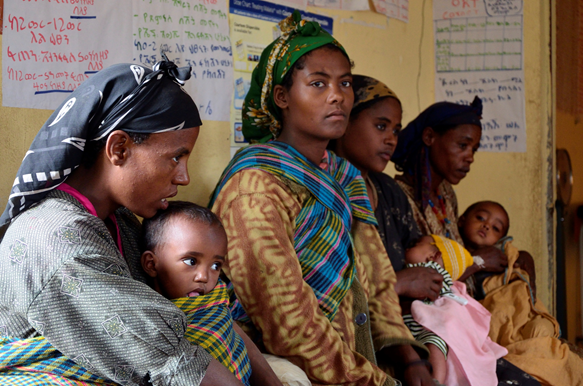Health in Ethiopia
Overview of Maternal, Newborn, and Child Health in Ethiopia

Mothers wait to receive service at a health facility.
Ethiopia is one among six countries which has more than 50% maternal death with 676 mothers out of 100,000 dying while giving birth. With each death there are another 20 women suffering from morbidity associated with child death.
Similarly, taking a look at the newborn situation, despite the fact that Ethiopia reached its child mortality reduction goal (MDG 4) two years earlier than the set target, neonatal mortality remains high. In 2011 neonatal (first 28 days of life) mortality was at 37/1000 live births thus account for 63% of all infant deaths and 42% of all under-five deaths.
However, since the 2011 Ethiopian Demographic and Health Survey (DHS) there are improvements in coverage of key maternal, newborn, and child health interventions with maternal and newborn mortality being on the decrease. High impact interventions have become more accessible with the launching of the Ethiopian Government’s health extension program. This has helped to address causes for newborn and maternal mortality and morbidity which are usually preventable.
The major causes of maternal deaths in Ethiopia are those observed in other developing countries: infection, hemorrhage, obstructed labor, abortion, and hypertension during pregnancy. The major and direct causes of newborn deaths are; infection 36%, intra-partum related complications (birth asphyxia) 25%, and prematurity 17% (CBNC Implementation Guideline, FMoH 2013).
In 2004, the Government of Ethiopia launched the Health Extension Program (HEP), with the aim to provide quality, promotive, preventive, and selected health care services in an accessible and equitable manner to reach all segments of the population and with special attention to mothers and children. Since the launch of the HEP, the government has built close to 15,000 health posts and deployed over 35,000 Health Extension Workers (HEWs) in all corners of the country.
Establishment of community mobilization strategy (the Health/Women Development Army) to increase demand for and utilization of maternal and newborn health care services and the restructuring of the Primary Health Care Unit for better linkage between the health post and health center are among the main strategies currently underway. Building the capacity and performance of health workers at all levels also plays an essential role.
Hence, with such efforts positive outcomes are already being recorded: reduction of maternal and newborn mortality rate, enhanced institutional delivery, increased antenatal care coverage and needs of emergency obstetric and newborn care of health facilities being met.

Trends in U5 and Neonatal Mortality Rates in Ethiopia

Maternal Mortality Ratio (MMR) Trend
